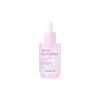What's inside
What's inside
 Key Ingredients
Key Ingredients

 Benefits
Benefits

 Concerns
Concerns

 Ingredients Side-by-side
Ingredients Side-by-side

Water
Skin ConditioningMethylpropanediol
SolventButylene Glycol
HumectantGlycerin
HumectantPropylene Glycol
HumectantPanthenol
Skin ConditioningHydrogenated Starch Hydrolysate
HumectantEthylhexylglycerin
Skin ConditioningBambusa Vulgaris Shoot Extract
AntioxidantNelumbo Nucifera Flower Extract
Skin ConditioningNymphaea Alba Root Extract
Skin ConditioningPalmitoyl Tripeptide-8
Skin ConditioningDextran
Parfum
MaskingPhenoxyethanol
PreservativeWater
Skin ConditioningMethylpropanediol
SolventDipropylene Glycol
HumectantPropanediol
SolventGlycerin
HumectantPolyglycerin-3
Humectant1,2-Hexanediol
Skin ConditioningBetaine
HumectantNiacinamide
SmoothingPentylene Glycol
Skin ConditioningMethyl Gluceth-20
HumectantOpuntia Ficus-Indica Fruit Extract
Skin ConditioningOctyldodeceth-16
EmulsifyingCholesteryl Isostearate
EmollientCholesteryl Chloride
Skin ConditioningCholesteryl Nonanoate
EmollientCarbomer
Emulsion StabilisingButylene Glycol
HumectantXanthan Gum
EmulsifyingLaminaria Japonica Extract
Skin ProtectingEclipta Prostrata Leaf Extract
Skin ConditioningSodium Acrylic Acid/Ma Copolymer
Lactobacillus Ferment
Skin ConditioningTromethamine
BufferingEthylhexylglycerin
Skin ConditioningAdenosine
Skin ConditioningFructooligosaccharides
HumectantParfum
MaskingHydrogenated Lecithin
EmulsifyingDisodium EDTA
Cyamopsis Tetragonoloba Gum
Emulsion StabilisingBeta-Glucan
Skin ConditioningAgar
MaskingSodium Hyaluronate
HumectantHydrolyzed Sodium Hyaluronate
Skin ConditioningSaccharomyces Ferment Filtrate
HumectantHydrolyzed Hyaluronic Acid
HumectantCentella Asiatica Extract
CleansingFicus Carica Fruit Extract
HumectantCaprylyl Glycol
EmollientCitrus Paradisi Fruit Extract
Skin ConditioningOpuntia Coccinellifera Fruit Extract
Skin ConditioningCeramide NP
Skin ConditioningSilica
AbrasiveTocopherol
AntioxidantHydroxypropyltrimonium Hyaluronate
Sodium Acetylated Hyaluronate
HumectantHyaluronic Acid
HumectantSodium Hyaluronate Crosspolymer
HumectantPotassium Hyaluronate
Skin ConditioningWater, Methylpropanediol, Dipropylene Glycol, Propanediol, Glycerin, Polyglycerin-3, 1,2-Hexanediol, Betaine, Niacinamide, Pentylene Glycol, Methyl Gluceth-20, Opuntia Ficus-Indica Fruit Extract, Octyldodeceth-16, Cholesteryl Isostearate, Cholesteryl Chloride, Cholesteryl Nonanoate, Carbomer, Butylene Glycol, Xanthan Gum, Laminaria Japonica Extract, Eclipta Prostrata Leaf Extract, Sodium Acrylic Acid/Ma Copolymer, Lactobacillus Ferment, Tromethamine, Ethylhexylglycerin, Adenosine, Fructooligosaccharides, Parfum, Hydrogenated Lecithin, Disodium EDTA, Cyamopsis Tetragonoloba Gum, Beta-Glucan, Agar, Sodium Hyaluronate, Hydrolyzed Sodium Hyaluronate, Saccharomyces Ferment Filtrate, Hydrolyzed Hyaluronic Acid, Centella Asiatica Extract, Ficus Carica Fruit Extract, Caprylyl Glycol, Citrus Paradisi Fruit Extract, Opuntia Coccinellifera Fruit Extract, Ceramide NP, Silica, Tocopherol, Hydroxypropyltrimonium Hyaluronate, Sodium Acetylated Hyaluronate, Hyaluronic Acid, Sodium Hyaluronate Crosspolymer, Potassium Hyaluronate
Ingredients Explained
These ingredients are found in both products.
Ingredients higher up in an ingredient list are typically present in a larger amount.
Butylene Glycol (or BG) is used within cosmetic products for a few different reasons:
Overall, Butylene Glycol is a safe and well-rounded ingredient that works well with other ingredients.
Though this ingredient works well with most skin types, some people with sensitive skin may experience a reaction such as allergic rashes, closed comedones, or itchiness.
Learn more about Butylene GlycolEthylhexylglycerin (we can't pronounce this either) is commonly used as a preservative and skin softener. It is derived from glyceryl.
You might see Ethylhexylglycerin often paired with other preservatives such as phenoxyethanol. Ethylhexylglycerin has been found to increase the effectiveness of these other preservatives.
Glycerin is already naturally found in your skin. It helps moisturize and protect your skin.
A study from 2016 found glycerin to be more effective as a humectant than AHAs and hyaluronic acid.
As a humectant, it helps the skin stay hydrated by pulling moisture to your skin. The low molecular weight of glycerin allows it to pull moisture into the deeper layers of your skin.
Hydrated skin improves your skin barrier; Your skin barrier helps protect against irritants and bacteria.
Glycerin has also been found to have antimicrobial and antiviral properties. Due to these properties, glycerin is often used in wound and burn treatments.
In cosmetics, glycerin is usually derived from plants such as soybean or palm. However, it can also be sourced from animals, such as tallow or animal fat.
This ingredient is organic, colorless, odorless, and non-toxic.
Glycerin is the name for this ingredient in American English. British English uses Glycerol/Glycerine.
Learn more about GlycerinMethylpropanediol is a synthetic solvent and humectant.
As a solvent, it helps dissolve other ingredients, helping to evenly distribute ingredients throughout the product. This ingredient has also been shown to have antimicrobial properties which makes it a preservative booster.
Methylpropanediol is able to add a bit of moisture to the skin. It also helps other ingredients be better absorbed into the skin, such as salicylic acid.
Learn more about MethylpropanediolParfum is a catch-all term for an ingredient or more that is used to give a scent to products.
Also called "fragrance", this ingredient can be a blend of hundreds of chemicals or plant oils. This means every product with "fragrance" or "parfum" in the ingredients list is a different mixture.
For instance, Habanolide is a proprietary trade name for a specific aroma chemical. When used as a fragrance ingredient in cosmetics, most aroma chemicals fall under the broad labeling category of “FRAGRANCE” or “PARFUM” according to EU and US regulations.
The term 'parfum' or 'fragrance' is not regulated in many countries. In many cases, it is up to the brand to define this term.
For instance, many brands choose to label themselves as "fragrance-free" because they are not using synthetic fragrances. However, their products may still contain ingredients such as essential oils that are considered a fragrance by INCI standards.
One example is Calendula flower extract. Calendula is an essential oil that still imparts a scent or 'fragrance'.
Depending on the blend, the ingredients in the mixture can cause allergies and sensitivities on the skin. Some ingredients that are known EU allergens include linalool and citronellol.
Parfum can also be used to mask or cover an unpleasant scent.
The bottom line is: not all fragrances/parfum/ingredients are created equally. If you are worried about fragrances, we recommend taking a closer look at an ingredient. And of course, we always recommend speaking with a professional.
Learn more about ParfumWater. It's the most common cosmetic ingredient of all. You'll usually see it at the top of ingredient lists, meaning that it makes up the largest part of the product.
So why is it so popular? Water most often acts as a solvent - this means that it helps dissolve other ingredients into the formulation.
You'll also recognize water as that liquid we all need to stay alive. If you see this, drink a glass of water. Stay hydrated!
Learn more about Water